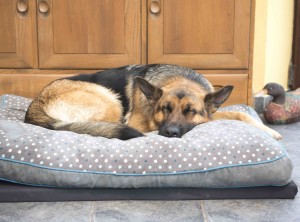 The problem
The problem
This article addresses the issue of barking at noises while in a house or apartment when the owner is home as well as absent. Dogs bark for many reasons. We can assume that dogs are barking at noises they hear outside the house because they are either startled, aroused or worried about the noise. There could also be the aspect of communicating to the other dogs and family members that they have heard a noise, which no doubt we selected dogs to do for thousands of years.
Barking can cause problems for us humans, like getting an angry note from the landlord. It can also cause problems for your dog. Worrying or being excited about what is outside while inside can mean that your dog will not be getting as much sleep and this can even cause chronic stress. Reacting to noises while at home is usually one of the root causes of other behavioral problems that show little or no improvement no matter how much time is spent with a behavior modification plan. For example, if you train your dog 100% of the time while on a walk around your neighborhood not to react to people or dogs, but then while you are at work an he reacts to the sounds of the people and dogs outside, it will prevent your training from progressing.
The solution
1 USE PREVENTION – Prevent your dog hearing the noises while you are not able to be there to train your dog and give your dog information.
2 “NOISY” TRAINING SESSIONS – Set up fun and easy training sessions to work with your dog in successful approximations.
3 REAL LIFE TRAINING – For every noise give your dog “feed back” 100% of the time until training is complete.
USE PREVENTION – Prevent your dog hearing the noises while you are not able to be there to train your dog and give your dog information.
 Try to prevent your dog hearing the noises when you are not around or not able to give your dog feedback. You can do this by closing the blinds, putting on the tv, fans or white noise machines. Obviously in some cases it might be impossible to drown out all the noises, but reducing them still is beneficial.
Try to prevent your dog hearing the noises when you are not around or not able to give your dog feedback. You can do this by closing the blinds, putting on the tv, fans or white noise machines. Obviously in some cases it might be impossible to drown out all the noises, but reducing them still is beneficial.
Prevent access to the noisiest parts of the house while you are away. If you live in an apartment, prevent access to the front door of the apartment or the room where your dog hears your noisy neighbor the most. You might need to keep your dog in just one room such as the bedroom or in the middle of your house with all the doors closed at first. Once your dog is no longer bothered by the noises, you can then increase your dog’s access to other parts of your house when he is alone.
Keep in mind if your dog has anxiety about being left alone, this can exacerbate the barking at noises, as well as the barking at noises can exacerbate anxiety about being left alone… So when working on any behavioral issue it’s good to address all the issues that can be affecting each other.
 Set your dog up for success by promoting sleeping when you are gone. Provide enough exercise and mental stimulation before leaving. You can also work on teaching your dog to settle on a dog bed in training sessions and then leave your dog with his bed when you are gone.
Set your dog up for success by promoting sleeping when you are gone. Provide enough exercise and mental stimulation before leaving. You can also work on teaching your dog to settle on a dog bed in training sessions and then leave your dog with his bed when you are gone.
“NOISY” TRAINING SESSIONS – Set up fun and easy training sessions to work with your dog in successful approximations.
Figure out what noises your dog is most likely reacting to. Find a way to make the noises yourself. For example, if your dog is reacting to dogs barking, you can record and replay the noises with your phone or search for noises on Youtube. If your dog is reacting to jingling keys, knocking or the noises of feet going by you can make those noises yourself.
In a training session, make the noise at a low volume, then feed a treat and talk to your dog in a calm voice. You want to make sure your dog is not startling at the noises, so start with them at a low volume and increase as your dog succeeds.
First make the noises inside your house. Then make the noises outside your house while your dog can see it is a friend or family member that is making the noise in the doorway and then from behind a visual barrier. Finally increase the silence between the noises.
If your dog has been reacting to noises it will take a few training sessions to condition a new emotional response to noises he hears. I suggest at least planning to do 6 sessions with this “Noisy” training before expecting results.
REAL LIFE TRAINING – For every noise give your dog “feed back” 100% of the time until training is complete.
While you are home, if you hear a noise BEFORE your dog barks at it, tell him he is good in a calm and friendly voice and then go get your dog a treat. You can keep treat jars with treats that don’t spoil easily throughout your house so they are easily accessible.
At first, feed a treat after EVERY noise you hear before your dog reacts. Do this for 2 weeks in a row to see a change in your dog’s behavior. In the future when your dog is comfortable with the noises you won’t have to give your dog treats anymore. So all your hard work will be paid off in the future. It is important to make sure your dog is not barking all day at the noises while you are gone though, as this will undo all the training you do when you are home.
What to do if your dog barks at a noise
If you are home and your dog barks at a noise before you can give him feedback or it is a noise you can’t hear, you can use a cue to interrupt the behavior such as the cue “Leave it” said in a positive tone of voice and then redirect your dog to what you would like him to be doing instead such as saying “Go to your bed”. It’s important to train these cues in training sessions using Positive Reinforcement and do brush up training sessions to maintain the power of the cues. Below are tutorials on how to train these cues.
Teaching the leave it cue:
https://www.youtube.com/watch?v=6jYfKK17ZBs
Go to your bed:
https://www.youtube.com/watch?v=U2c5EkytNU0
You can also take your dog’s collar and calmly lead him away from the area he is barking, but it is important to train this as a cue to move with you first. See the tutorial below. If you think your dog might bite you or you are not sure what your dog might do, hire a professional trainer to help you first.
Teaching the collar grab cue:
https://www.youtube.com/watch?v=62NNwZtbtIA
Simply interrupting your dog when he starts barking as a training method is not going to solve the problem. The most important part of any behavior modification plan is reinforcing your dog for what you DO want him to do. This is best done in the training set-ups where you are feeding your dog a treat for not reacting to the noises and you are controlling when the noises happen.
The future
In the future after training, if your dog hears an unusual noise and looks alarmed or alert, communicate with your dog. Tell your dog you heard the noise too in a calm and reassuring voice and tell him it’s not a problem. You can also smile and blink at your dog to let your dog know that it’s nothing to worry about. By repeating this, noises will start to predict you being calm and relaxed and make your dog more likely to be calm when hearing noises in the future.
If you learn better while listening, here is a video that goes over the same topic and has visual examples:
Copyright of Emily Larlham 2019
